Value-Based Apple Search Ads Account Structure
 Anastasia Sidoryk
Anastasia Sidoryk
By structuring your Apple Search Ads account you can improve ad relevance, assess performance more accurately and lay the foundation for scaling.
We’ve already explained high-level ideas of how to build your Apple Search Ads account structure. In this article, we’re going to cover one of the two specific approaches that we offer – value-based structuring. The other one, the semantics-based Apple Search Ads account structure, is covered in Lesson 6 of The Complete Apple Search Ads Course.
Value is one of the most effective ways to structure your Apple Search Ads account.
Basically, a value-based account structure presupposes that you organize keywords into different campaigns based on the value that users who search using these keywords bring to you as an app marketer.
Let’s go deeper and deconstruct all high-level concepts that make up this strategy. Above all, we should figure out what benefits we get at each level of the campaign or the account components within Apple Search Ads.
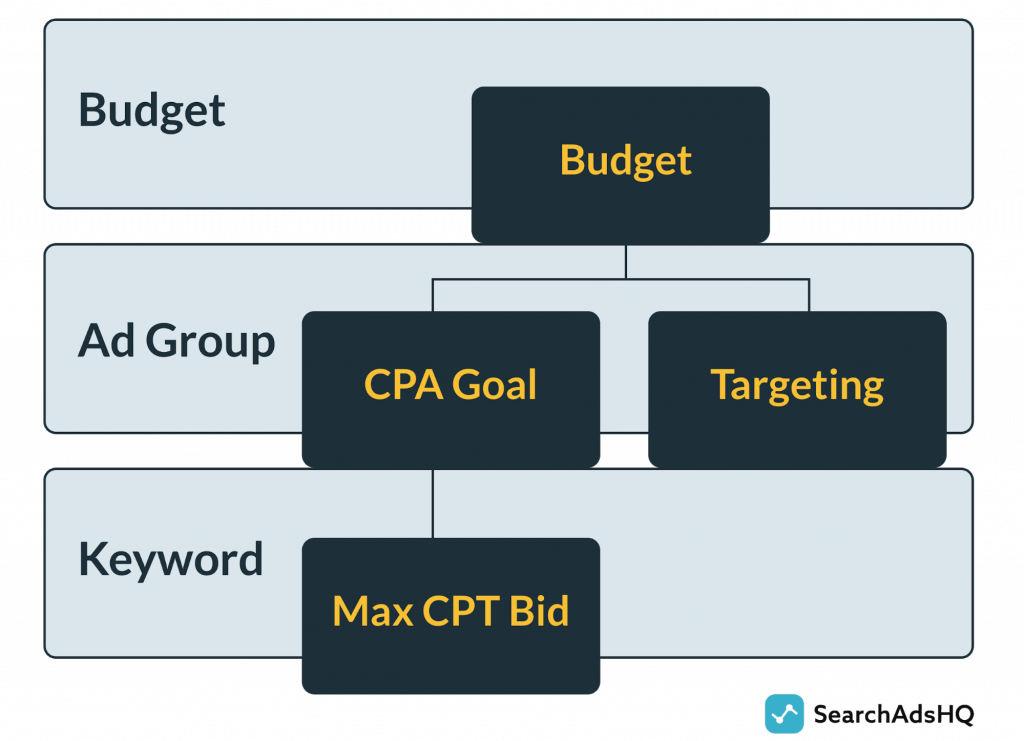
Campaign level. When it comes to campaigns, you get control over the budget. This allows you to optimize your budget for the best expenditure. Essentially, you want to put more budget to where it produces higher value users and less budget to the keywords and targets that bring lower value users.
Ad group level. When you split keywords into ad groups, you get control over the CPA goal which is very useful for ensuring that you only pay a certain amount per download. You can also control Apple Search Ads targeting here (devices, time of day, weekday, gender, demographic, etc.).
Keep in mind that negative keywords exist at the campaign and ad group levels.
Keyword level. Here you control the bid. However, be aware that there is an interplay between the CPA goal and the CPT bid. When the CPA goal is set, it takes more precedence over your impression share than your CPT bid.
The value-based structure takes advantage of different abilities that you get at different levels of your Apple Search Ads account hierarchy.
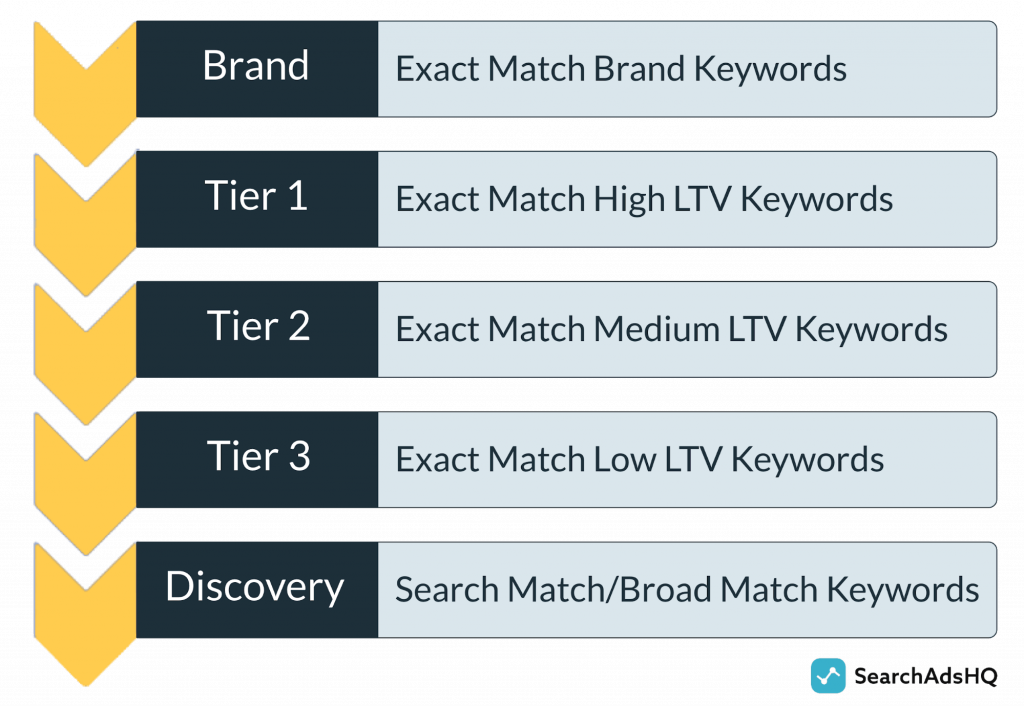
The recommended structure should have:
As for the match types, keep in mind that the brand and tiered (known/assumed high-value keywords) campaigns should include only exact match keywords and have the highest bids.
The purpose of an Apple Search Ads discovery campaign is to uncover new search terms for tiered campaigns, meaning that it should have Search Match and broad match keywords with bids high enough to be competitive in an auction and produce search term-level visibility.
Mind that it’s necessary to add all the keywords that you use in exact match groups to the discovery campaign as negative exact match keywords to avoid competition for impressions.
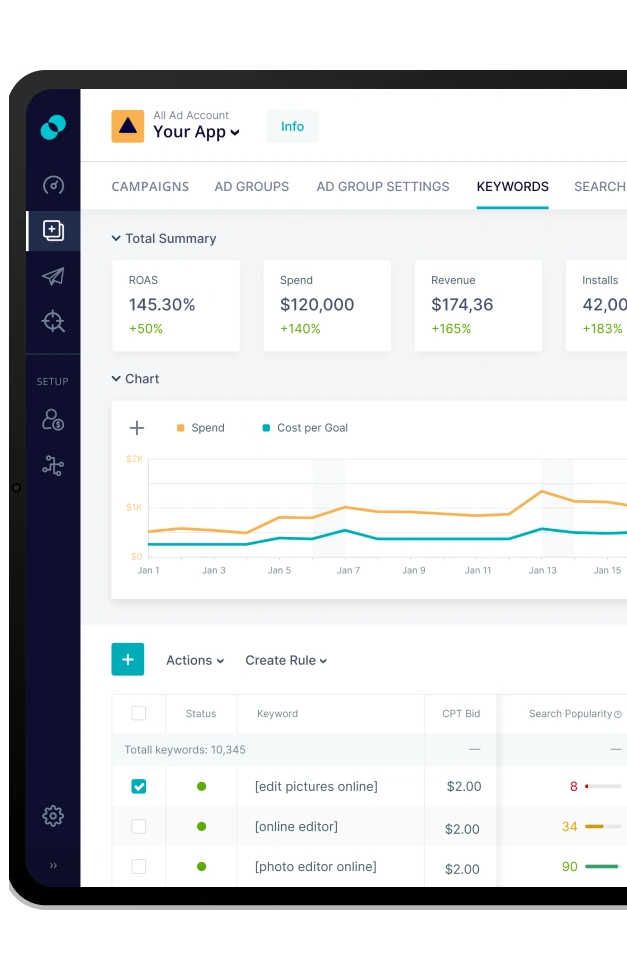
As it was mentioned above, you should calculate the value for keywords and group them by how much value they bring to you as an app marketer. By breaking out keywords into separate campaigns by tiers, you get more control over the budget. How to do it though?
According to Gabe Kwakyi from Incipia, users and keywords distribution can be illustrated the following way:
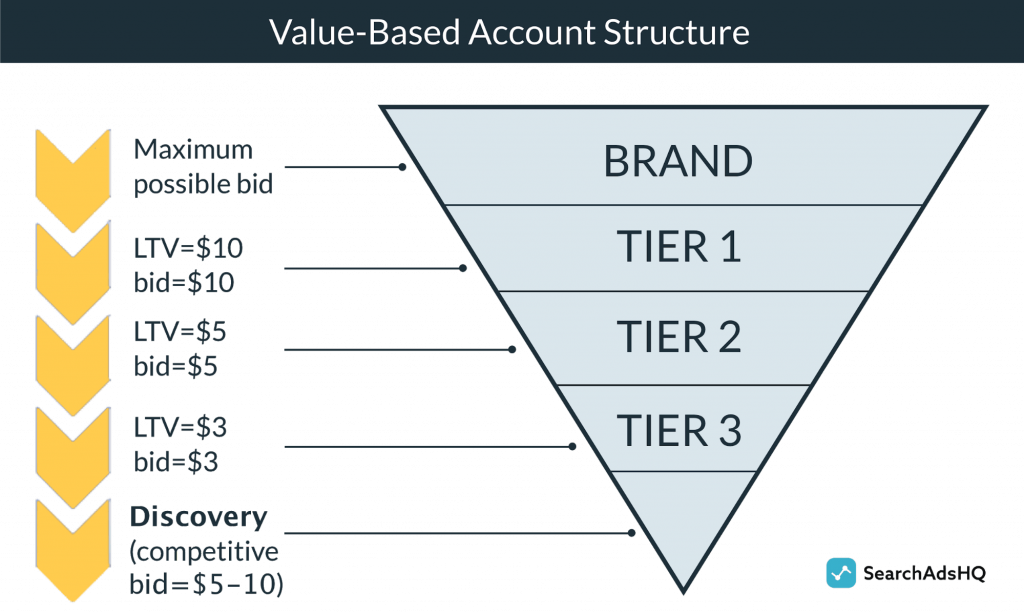
Let’s examine all levels of this reverse pyramid and see how the value, bid and budget change as you go down.
The bid and the value are key concepts that predefine the grouping of users and keywords. You should put your maximum possible bid in your brand campaign. Thus, you can get as many users who are interested in your brand as possible. It goes without saying that such users are likely to turn into high-value ones.
When you make decisions regarding the Tier 1 campaign, you’re going to find the keywords which bring high LTV users. Tier 1 keywords should have a fairly high bid again as you want to have the bid that’s competitive enough to give you the highest possible impression share for these users.
Moving down to Tier 2, these users are going to be grouped by a medium value. They’re a little less valuable than Tier 1 but more valuable than Tier 3. Therefore, your bid is going to be lower than for Tier 1 but higher than for Tier 3.
Tier 3 is where you’re going to have the lowest bid of all the tiers unless you have a Tier 4 or 5 because these users have the lowest value for your business.
As for the Discovery campaign, you’re going to want to have a bid on par with your Tier 2 or Tier 1 campaign bids. The thing is the purpose of the discovery campaign is to be competitive enough in order to discover new search terms that you can push into your tiered campaigns. So it makes sense to give this discovery campaign enough resources to compete with other advertisers out there and get you access to new search terms.
As the discovery campaign begins gaining search term-level visibility, it’s important to transfer the search terms into tiered campaigns based on their TTR/CR/CPA. Keywords should be negated in the discovery campaign and added as exact match keywords to the appropriate campaign and ad group.
Over time, the amount of budget spent on the discovery campaign is going to decline as you push search terms into your tiered campaigns. However, in the beginning, you will spend more budget on this campaign as you’re building your keyword knowledge.
Some Apple Search Ads managers notice that they discover all the keywords that are valuable after a certain period of time. For this reason, they shut down the exploration of new keywords.
While there is some merit to this approach, it still makes sense to keep the discovery campaign due to the nature of the user experience on the App Store. New apps and brands are popping up every day. Considering that brand and app names make about 60% of the total searches, if you don’t keep your discovery campaign going, it’ll be pretty difficult to continue identifying the app names that are created on a daily basis and add them to your campaigns.
It’s easier to just keep your discovery campaign going and check the search term logs to make sure that you have full coverage. The campaign should include Search Match and broad match ad groups.
You can go further and create an additional Probing/Proxy campaign. It should include the search terms you revealed in your discovery campaign as exact match keywords. Essentially, this is where you check whether the discovered keywords show a good conversion rate to subscription/purchase using the data from your MMP or running your Apple Search Ads campaigns with SearchAdsHQ.
If the results are positive enough, the keywords should be transferred to one of the tiered campaigns accordingly. Thus, probing campaigns help you take a step away from educated guesses and make more data-driven decisions. Yet, they require time and additional investment.
As it was mentioned above, you have two options when it comes to tier-related decisions:
Let’s examine the latter option in more detail.
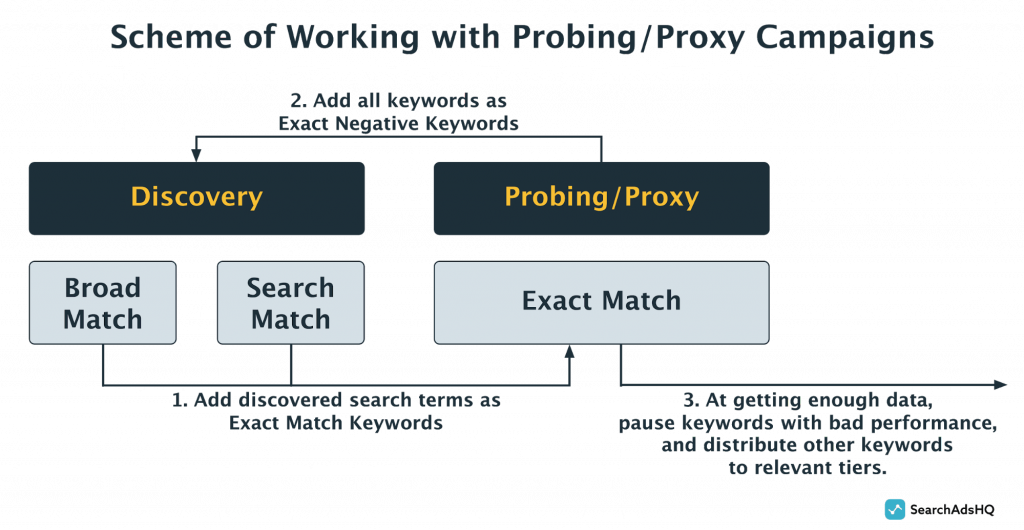
When creating a proxy campaign, you have to fill it with all kinds of keywords you discovered as exact match. Your keywords should stay in this group unless you have enough data on their performance. Mind that bids should be competitive enough to aggregate data on keywords performance.
When it comes to defining bids, there are 2 common scenarios:
In theory, everything is easy — keywords with low LTV are added to negative ones and keywords having the best performance within the probing campaign go to Tier 1, and so on. Yet, what is good performance?
To evaluate keywords performance, you should track certain Apple Search Ads metrics which become a barometer of keywords efficiency.
Sure, tracking the bottom of your user acquisition funnel (purchase or subscription) seems the best option as such actions are the most meaningful and demonstrative. Unfortunately, this strategy is hardly ever in touch with reality.
It’s necessary to spot at about 50-100 events per keywords to come to a decision. Mind that events should be frequent enough to allow you to evaluate keywords performance. On top of that, event stability is another important factor: an event that happens once a month is unlikely to help you.
Keep in mind that at the end of the day your tier-related decision should be based on keywords LTVs.
So how are actions related to LTV? Everything is pretty straightforward: provided that an average action value stays the same, the more actions a keyword generates, the greater its impact on average revenue per user (ARPU) and therefore on LTV. If an average action value differs, it’s necessary to refer to the keyword’s impact on Return On Advertising Spend (ROAS).
When it comes to actions, we normally refer to such metrics as Cost-per-Action (CPA) and target Cost-per-Action (t-CPA which you define yourself). So keywords performance and division into Tiers will mainly be defined by your conversion rate if we consider that:

Let’s calculate bids for different tiers providing our t-CPA = $20:
This example is hypothetical, and app marketers should make their decisions based on the peculiarities of their business. However, you can stick to the same logic using the approach which involves CPA Goal and a high bid.
As it was mentioned above, some actions (purchase, subscription) are rare and won’t give you enough data for optimization. That’s why you should opt for a more frequent event that precedes the action. It can be Install, then you will have to work with target Cost-per-Install (t-CPI).
The key part of the tiered strategy is to waterfall your budget down the pyramid. This process ensures that the budget is prioritized by the keywords driving value for your bottom line, while also mitigating the risk of lower value keywords dragging down your profit margins.
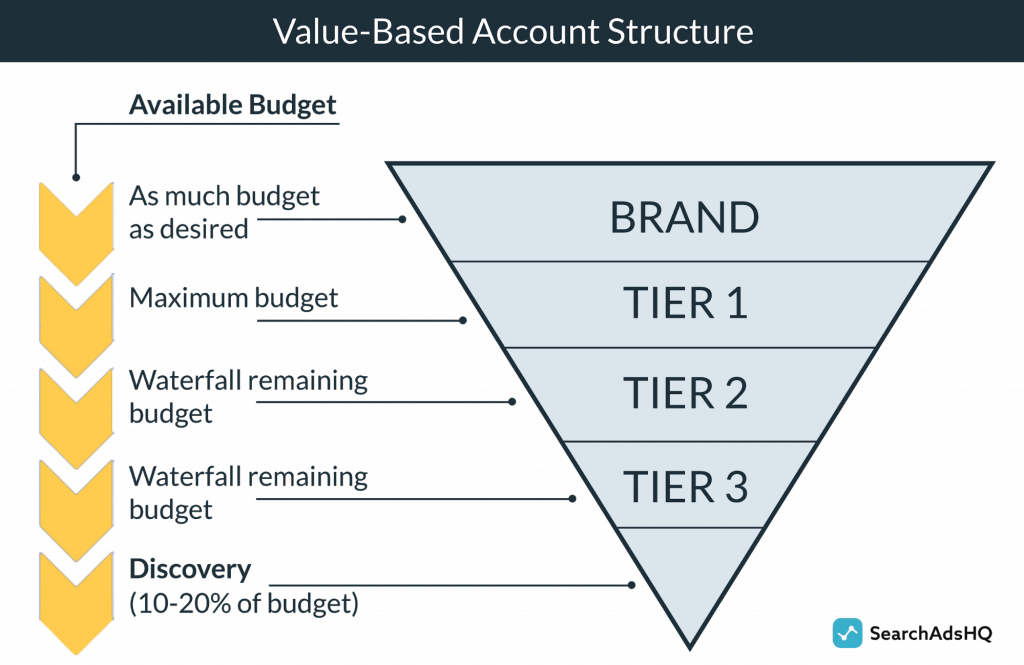
Therefore, your brand campaign is going to have as much budget as possible. Start there and then waterfall the remaining budget down into the tiered campaigns.
You’re also going to want to spend a considerable budget share on Tier 1. Figuring out how much budget to spend on Tier 1 is a dynamic process. The keywords that bring high-value users typically have lower volumes. So you won’t be able to assign 50% of your budget to the Tier 1 keywords because they won’t probably be able to spend that much.
The goal here is to spend as much as you can on Tier 1 and then push the remaining budget down to Tier 2 and Tier 3.
And again, you’d want to make sure that a certain percentage of your budget is reserved for exploration.
Note that the discovery campaign budget shouldn’t be factored into the overall ROI equation as its purpose is not to drive ROI. Despite its lower ROI and gradual decline in scale (as more negatives are added), the discovery campaign will ensure your visibility into new valuable search terms.
According to our report on Apple Search Ads Keywords Performance, top spenders allocate around 11.8% of their budget to Search Match on average.
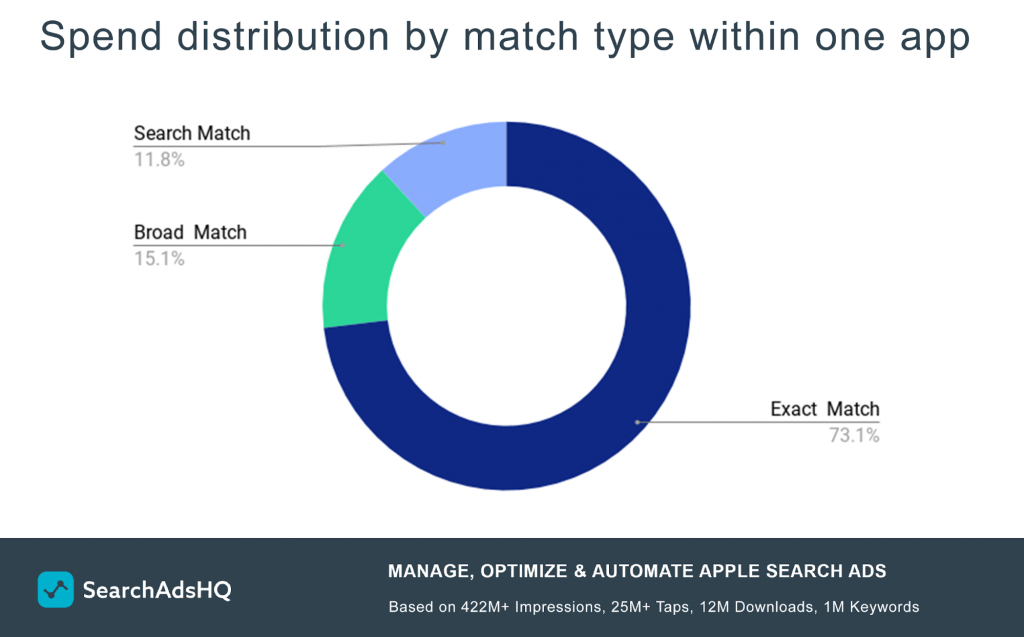
Considering the chart above and the fact that broad match and Search Match are mainly used in discovery campaigns to find high-performing keywords, SearchAdsHQ top spenders allocate slightly more than 20% on running discovery campaigns and approximately 80% on exact match campaigns. Thus, it’s a good practice to spend 10-20% of your budget on exploration.
You should be comfortable spending the discovery campaign budget in a not very efficient manner. However, when it comes to your tiered campaigns, make sure that the budget is being spent wisely.
Keywords should be organized by LTV bands with appropriate bids within tiered campaigns. Using the ad group CPA is a great way to control a bid by value. On top of that, such an account structure is illustrative and it sets ads managers up to tap into.
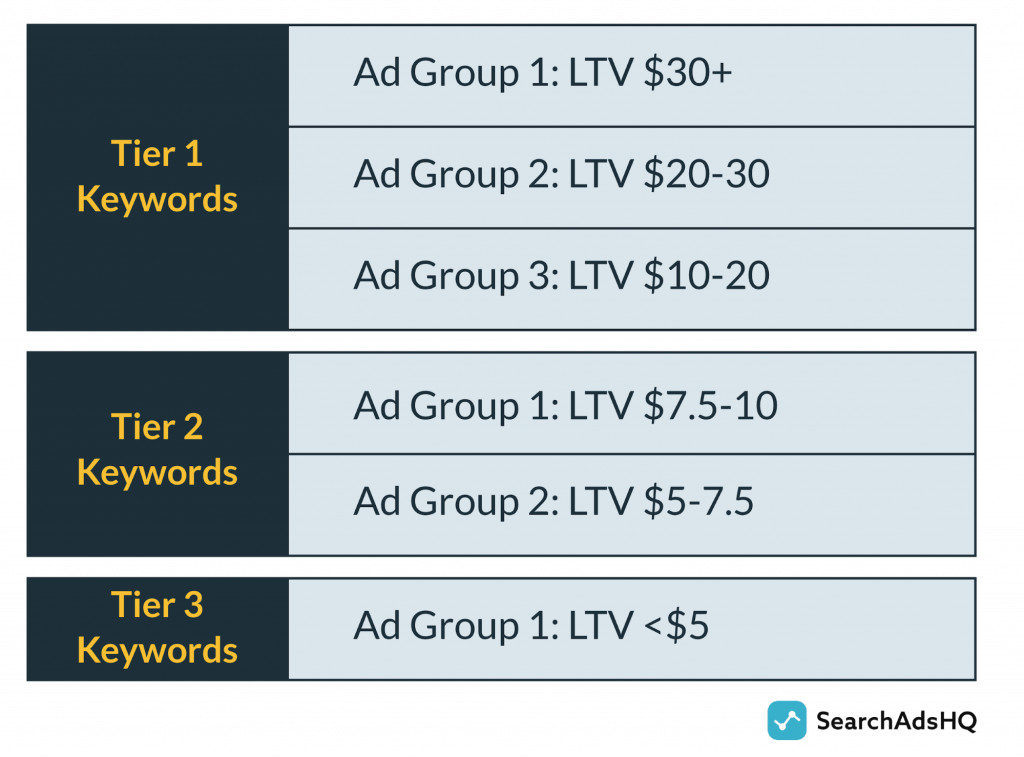
Mind that the numbers featured in the example above are illustrative and they’re not what should be necessarily used for your campaigns. They just serve the purpose of showing you the differences between the tiers.
Again, you should spend as much money as possible on Tier 1, and as for the remaining budget, try to allocate as much as you can for Tier 2. What is left is allocated for Tier 3.
When it comes to Tier 1, make sure that you use exact match keywords as here you’re getting traffic only from search terms that bring high-value users. In the example above, we’ve defined Tier 1 or high-value keywords as those with an LTV of 10 dollars or more. It’s necessary to use a very competitive bid to get as much traffic from these keywords as possible.
Remember that you can subdivide the tiers into more ad groups. The more granular your segmentation, the more manageable your reports are. For example, we can have the following segmentation:
If you use the CPA Goal, make sure that it’s competitive. If you decide to use it, CPA Goal will take precedence in deciding your impression share over CPT bid. Splitting keywords into separate ad groups gives you control over CPA Goal.

Mind that keywords that fit into Tier 1 are typically long-tail ones. Generally, this means that a user has a more formed and more intentional desire to download an app that fulfills their exact need. The keywords evolve through the tiers becoming shorter-tail and less specific.
It’s necessary to understand that generally, a floor price for tiered keywords can’t be under 3 dollars. This happens because ad managers eventually see a shakeout of a general customer acquisition cost where it’s difficult to acquire users below this sum.
Sure, there will be a lot of keywords or at least some keywords that you can acquire for a better price but the value of the users they bring is not worth it. And when you try to reduce the bid, you’ll find that your scale will go down to zero or close to zero.
So if keywords bring users whose value isn’t high enough to justify the cost, it’s better to turn such keywords off. Nevertheless, you can keep exploring them. It might be helpful to turn them on again from time to time to see if you can get the customer acquisition cost equal to the LTV. But generally, there will always be some keywords that are just not worth it.
In the end, your Apple Search Ads account structure should look the following way:
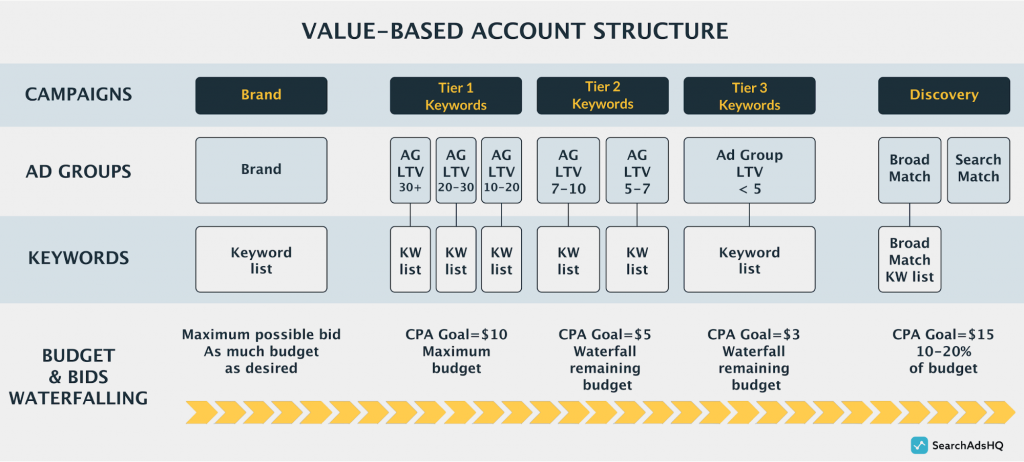
Remember that the most important thing is to make sure that the sum you’re paying to acquire a user is equal to your value per user. So your LTV should equal your customer acquisition cost.
How can it be tracked?
Well, you can manually check the revenue that keywords bring in your MMP and then compare it to the statistics from your Apple Search Ads account. There’s another option though, which doesn’t involve going back and forth. You can manage your Apple Search Ads campaigns with the help of SearchAdsHQ which provides an end-to-end look at your media buying funnel, uniting data from the above-mentioned sources within a single dashboard.
Naturally, managing a value-based account structure may cause certain problems. According to Gabe Kwakyi, here are some challenges that you may face:
As it was mentioned before, the highest value keywords will typically have the lowest scale, and the lowest value keywords will have the highest scale. It can be challenging to dynamically allocate the budget for each tier so that the tiers below could get the remaining budget, but without throwing your overall ROI out of balance.
As the search term auctions, Apple Search Ads and your app itself change, the value of each keyword will change as well, causing the need to potentially re-categorize keywords according to their updated value. Moving keywords around can cause adverse reactions in performance, especially for the keywords that gain momentum.
With lower budgets, this strategy may require more effort than is worth it. The effort level may be reduced by using ad groups for value tiers instead of campaigns. But be careful not to let lower performing keywords consume too much budget.
Before a search term is added as an exact match keyword, there is no downstream visibility from the MMP. This can make it tough to assess the right tier for a search term to be added into. This challenge is not easily resolved, but can either be approached by either:
On top of that, some keywords will make categorization by value difficult, due to the changes in auction performance. While the most straightforward definition of Tier 1 is by LTV, as mentioned above, moving keywords can be detrimental to performance. In the case of keywords with the volatile (but occasionally great) performance, it may be beneficial to split these keywords into their own campaigns, with their own budget.
Please, keep these challenges in mind when building your value-based Apple Search Ads account structure.
Sure, approach to tiering keywords and campaigns may seem a bit complicated at first. Still, it is worth trying as when done right, such an account structure may bring progressively higher ROI, especially as your campaigns scale, which ultimately enables you to bid even higher and drive additional scale.
Furthermore, if you spare time to master an advanced segmentation and efficiency extraction, you will also learn a new frame of mind that can be applied to other areas of your marketing strategy.

